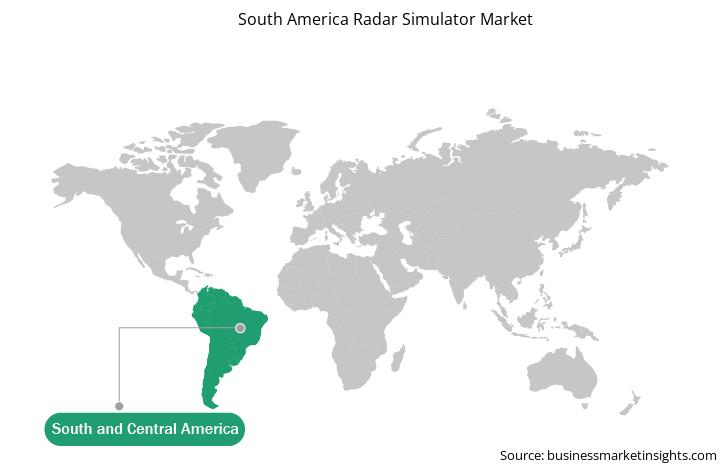The radar simulator market in South America is expected to grow from US$ 73.35 million in 2022 to US$ 85.10 million by 2028; it is estimated to grow at a CAGR of 2.5% from 2022 to 2028.
There is a continuous rise in concerns regarding security at public places; national borders; and navy, land, and air force bases. Effective management and control of airborne, naval, or ground threats with the help of radar systems has become an important paradigm for the military and security authorities of the region. There is an increase in the adoption of radar systems and radar simulators to ensure the safety of military operations and personnel and to provide efficient training for radar operators. Many countries are procuring radar simulators to strengthen their respective military forces and train operators to combat the threats from advanced air strikes that occur on a frequent basis. Radar simulators further help military officials devise counter plans for attacks from unidentified threats. Radar simulator procurement has increased in the military sectors across various countries, and governments in these countries are proposing higher military spending to help the military and defense sectors procure more advanced radar systems and radar simulators. Thus, the increasing military procurement of radar simulators is driving the market.
Strategic insights for the South America Radar Simulator provides data-driven analysis of the industry landscape, including current trends, key players, and regional nuances. These insights offer actionable recommendations, enabling readers to differentiate themselves from competitors by identifying untapped segments or developing unique value propositions. Leveraging data analytics, these insights help industry players anticipate the market shifts, whether investors, manufacturers, or other stakeholders. A future-oriented perspective is essential, helping stakeholders anticipate market shifts and position themselves for long-term success in this dynamic region. Ultimately, effective strategic insights empower readers to make informed decisions that drive profitability and achieve their business objectives within the market. The geographic scope of the South America Radar Simulator refers to the specific areas in which a business operates and competes. Understanding local distinctions, such as diverse consumer preferences (e.g., demand for specific plug types or battery backup durations), varying economic conditions, and regulatory environments, is crucial for tailoring strategies to specific markets. Businesses can expand their reach by identifying underserved areas or adapting their offerings to meet local demands. A clear market focus allows for more effective resource allocation, targeted marketing campaigns, and better positioning against local competitors, ultimately driving growth in those targeted areas.South America Radar Simulator Strategic Insights

South America Radar Simulator Report Scope
Report Attribute
Details
Market size in 2022
US$ 73.35 Million
Market Size by 2028
US$ 85.10 Million
Global CAGR (2022 - 2028)
2.5%
Historical Data
2020-2021
Forecast period
2023-2028
Segments Covered
By Component
By System
By Application
Regions and Countries Covered
South and Central America
Market leaders and key company profiles
South America Radar Simulator Regional Insights

South America Radar Simulator Market Segmentation
The South America radar simulator market is segmented based on component, system, application, and country. Based on component, the market has been segmented into hardware and software. The hardware segment would dominate the South America radar simulator market in 2022. In terms of system, the market is divided into system testing and operator training. The operator training segment would dominate the South America radar simulator market in 2022. Based on application, the market has been bifurcated into military and commercial. The commercial segment dominated the South America radar simulator market in 2022. Based on country, The South America radar simulator market is segmented into Brazil and the Rest of South America. Brazil would dominate the market in 2022.
Key players operating in the South America radar simulator market include Adacel, Technologies Limited, ARI Simulation, Collins Aerospace, Micro Nav Limited, and Textron Inc.
The South America Radar Simulator Market is valued at US$ 73.35 Million in 2022, it is projected to reach US$ 85.10 Million by 2028.
As per our report South America Radar Simulator Market, the market size is valued at US$ 73.35 Million in 2022, projecting it to reach US$ 85.10 Million by 2028. This translates to a CAGR of approximately 2.5% during the forecast period.
The South America Radar Simulator Market report typically cover these key segments-
The historic period, base year, and forecast period can vary slightly depending on the specific market research report. However, for the South America Radar Simulator Market report:
The South America Radar Simulator Market is populated by several key players, each contributing to its growth and innovation. Some of the major players include:
The South America Radar Simulator Market report is valuable for diverse stakeholders, including:
Essentially, anyone involved in or considering involvement in the South America Radar Simulator Market value chain can benefit from the information contained in a comprehensive market report.